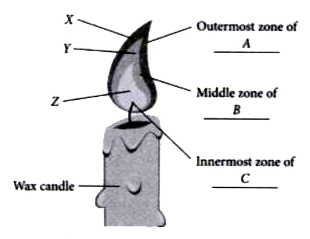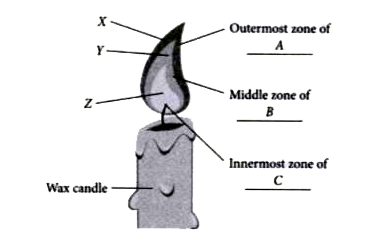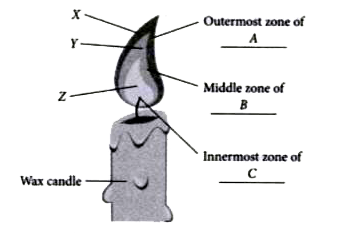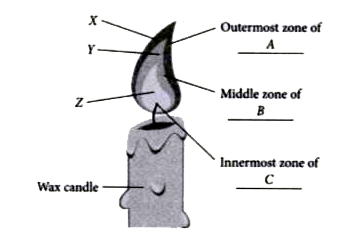The substance that does not burn with flame is
LPG
camphor
dry grass
charcoal
The correct Answer is:D
To determine which substance does not burn with a flame, we will analyze the given options one by one.
1. Identify the Options: The options given are LPG, camphor, dry glass, and charcoal.
2. Analyze LPG:
- LPG stands for liquefied petroleum gas.
- It is a gas that burns with a flame when ignited.
- Conclusion: LPG burns with a flame.
3. Analyze Camphor:
- Camphor is a substance that can undergo sublimation, transitioning from solid to gas without becoming liquid.
- When camphor is heated, it burns and produces a flame.
- Conclusion: Camphor burns with a flame.
4. Analyze Dry Glass:
- Dry glass is not a combustible material.
- It does not burn or produce a flame when heated.
- Conclusion: Dry glass does not burn with a flame.
5. Analyze Charcoal:
- Charcoal is a carbon-rich residue that remains after burning wood.
- While charcoal can smolder and produce heat, it does not produce a visible flame when it burns.
- Conclusion: Charcoal does not burn with a flame.
6. Final Conclusion:
- Among the options, dry glass and charcoal do not burn with a flame.
- However, since the question asks for a substance that does not burn with flame, the best answer is charcoal, as it is a substance that is typically associated with burning but does not produce a flame.
Final Answer:
Charcoal is the substance that does not burn with a flame.
---
- LPG stands for liquefied petroleum gas.
- It is a gas that burns with a flame when ignited.
- Conclusion: LPG burns with a flame.
- Camphor is a substance that can undergo sublimation, transitioning from solid to gas without becoming liquid.
- When camphor is heated, it burns and produces a flame.
- Conclusion: Camphor burns with a flame.
- Dry glass is not a combustible material.
- It does not burn or produce a flame when heated.
- Conclusion: Dry glass does not burn with a flame.
- Charcoal is a carbon-rich residue that remains after burning wood.
- While charcoal can smolder and produce heat, it does not produce a visible flame when it burns.
- Conclusion: Charcoal does not burn with a flame.
- Among the options, dry glass and charcoal do not burn with a flame.
- However, since the question asks for a substance that does not burn with flame, the best answer is charcoal, as it is a substance that is typically associated with burning but does not produce a flame.
Charcoal is the substance that does not burn with a flame.
Topper's Solved these Questions
- COMBUSTION AND FLAME BOOK - NCERT EXEMPLARCHAPTER - COMBUSTION AND FLAME EXERCISE - VERY SHORT ANSWER QUESTIONS (Fill in the blanks in the following sentences. )
9 Videos
- COMBUSTION AND FLAME BOOK - NCERT EXEMPLARCHAPTER - COMBUSTION AND FLAME EXERCISE - SHORT ANSWER QUESTIONS
12 Videos
- COAL AND PETROLEUMBOOK - NCERT EXEMPLARCHAPTER - COAL AND PETROLEUMEXERCISE - LONG ANSWER QUESTIONS
9 Videos
- CONSERVATION OF PLANTS AND ANIMALS BOOK - NCERT EXEMPLARCHAPTER - CONSERVATION OF PLANTS AND ANIMALS EXERCISE - LONG ANSWER QUESTIONS
3 Videos
Similar Questions
Knowledge Check
A flame is the visible gaseous part of a fire. It is a zone of combustion of gaseous substances accompanied by evolution of heat and light. All substances do not burn with a flame. Only those substances that vaporise during burning produce flame. A candle flame is taken to study the various zones of a flame.

The luminous and non-luminous zones of flame is respectively.AOutermost, middle zoneBInnermost, outermost zoneCMiddle, outermost zoneDOutermost, innermost zoneA flame is the visible gaseous part of a fire. It is a zone of combustion of gaseous substances accompanied by evolution of heat and light. All substances do not burn with a flame. Only those substances that vaporise during burning produce flame. A candle flame is taken to study the various zones of a flame.

Which zone of a candle flame is the zone of no combustion?AOutermost zoneBMiddle zoneCInnermost zoneDNone of theseA flame is the visible gaseous part of a fire. It is a zone of combustion of gaseous substances accompanied by evolution of heat and light. All substances do not burn with a flame. Only those substances that vaporise during burning produce flame. A candle flame is taken to study the various zones of a flame.

Arrange X, Y and Z in increasing order of temperature.AX<Y<ZBZ<Y<XCZ<X<YDY<Z<X
A flame is the visible gaseous part of a fire. It is a zone of combustion of gaseous substances accompanied by evolution of heat and light. All substances do not burn with a flame. Only those substances that vaporise during burning produce flame. A candle flame is taken to study the various zones of a flame.

(A), (B) and (C) are respectively.
View SolutionA flame is the visible gaseous part of a fire. It is a zone of combustion of gaseous substances accompanied by evolution of heat and light. All substances do not burn with a flame. Only those substances that vaporise during burning produce flame. A candle flame is taken to study the various zones of a flame.

Different zones of a candle flame are marked by the letters (A), (B) and (C).
Which of the following statements are correct?
(I) (B) is the hottest part of the flame.
(II) (C) is moderately hot.
(III) (A) is the hottest part of the flame.
(IV) (A) is moderately hot whereas (C) is the coldest part.
(V) (C) is the luminous zone.
(VI) (B) is the luminous zone.
(VII) (A) is the dark zone.
View SolutionWax burns with a flame because
View SolutionA gas which burns with blue flame is
View SolutionA gas which burns with blue flame is
View Solution
